We get our ryokan receptionist to help us with the reservation, and then eagerly turn up to Chef's 2-michelin star restaurant - Kichisen. As a nice touch, one of the waiters is standing outside the restaurant by the roadside in sub-10 degree weather specifically to greet us at the door. We're guided in and are welcomed by another waiter in full kneeling bow (with forehead touching the floor) - which is a little disconcerting, to be honest.

~ Yes ... exactly like this guy ~
Japanese hospitality culture shock aside, we're ushered into a private room and get comfortable to wait for the smorgasbord of food that's coming. While waiting we're served some nice pickled Cherry Blossom (sakura) tea (light, refreshing, a hint of sour) and Chef Tanigawa makes an appearance to pour us some warm sake to open up the meal.

Before we start though, let me insert a disclaimer that thanks to the language barrier (my half past six command of Japanese vs the staffs atrocious command of English), some of these ingredients and course names could be a little inaccurate. Or a lot inaccurate. Apologies in advance.
Sakizuke (先附): Tempura Yuzu ball, Shijimi (Corbiculidae, type of shellfish) and assorted seasonal spring vegetables - warabi (Japanese bracken fern), soramame (fava beans), fuki (bog rhubarb), kombu kelp and avocado with miso. This first appetizer dish sets the tone for the rest of the meal - fresh, local, seasonal, where the focus is on tasting the produce rather than drowning them out in heavy seasoning.
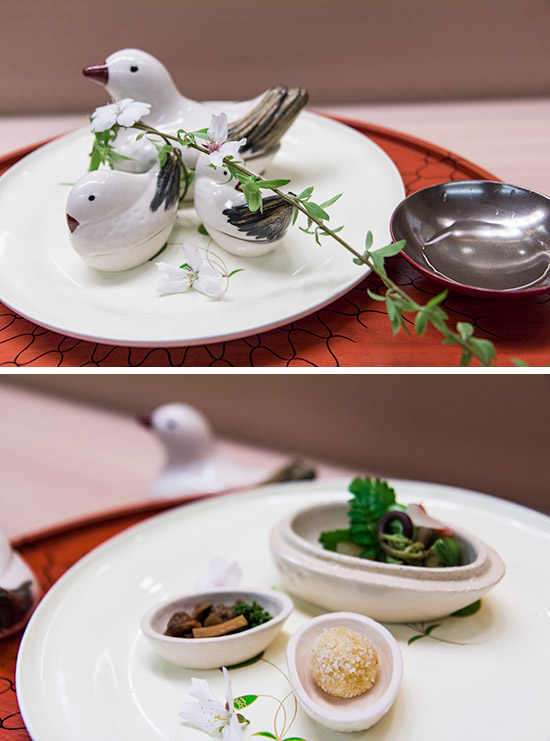
To cleanse the palate, up next is a cold onion soup. It's refreshing with a pretty even onion - milk/cream flavour profile, with a consistency bordering on a light frothy foam (rather than a soup).

Futamono (蓋物): Aburame (Fat Greening fish) with Ame (Deep Red Plum) and Yuzu flowers served in a to-die-for clear fish stock. The fish has been simmered to perfection - sweet, and flaky flesh without being too firm. We're instructed to suck "just a little" of the accompanying plum for just the right sour finishing touch. We're not as enthusiastic about the yuzu flowers though, they've got a taste that's a little alien to our taste buds.
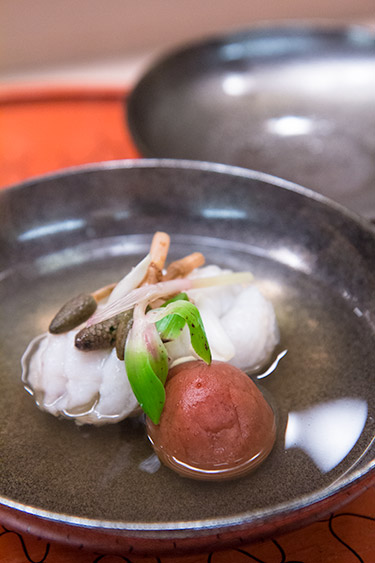
Mukōzuke (向付): Seasonal sashimi. We get some Uni (sea urchin), Toro (Tuna Belly), Ika (Squid), Tai (Sea Bream), Ebi (Shrimp) and some sort of snapper whose name eludes us. As expected, the sashimi is uber fresh (our shrimp was still twitching when served), and perennial favorites Toro and Uni don't disappoint. We've never appreciated raw squid though, because of its' questionable texture.

We also don't care much for the next dish (Nakazara) - a substantial piece of Unagi (Freshwater Eel) steamed with rice in a huge piece of kelp. The entire thing is perhaps a little too soggy and broken up for our liking.
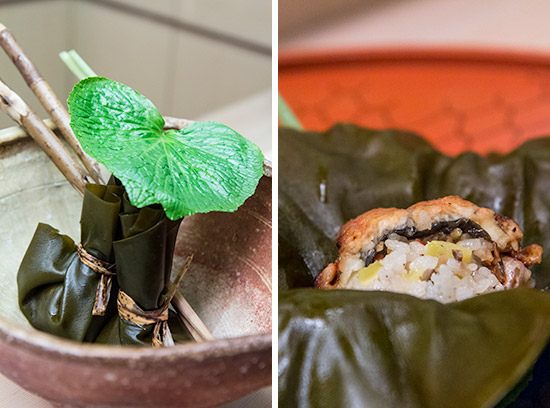
The next course is by some margin the prettiest food we've ever been served. It's a collection of different ingredients (again, many of them only available in the Spring) cooked in a variety of styles; each in its' own cute little bowl and sprinkled liberally with cherry blossom petals.

Among others we have some bean curd skin with gold flake jelly, fried baby squid, skewers of yam, scallop and toddler squid (for lack of a better word), kinome miso, cucumber, noshi ume (plum and arrowroot starch) and namako (sea cucumber). We had a hell of a time tasting and comparing all the many flavors of the different dishes.

Nimono: A generous helping of steamed Bamboo Shoots accompanied with kelp and an extremely pungent tasting fern in soup. For me this was the weakest dish of the night because the fern tasted so alien, and it was pretty astringent and ended up both overpowering the mild taste of the bamboo and leaving a tingling semi-numbness on the tongue.

Yakimono (焼物): Trout on a thin slice of pineapple served on hot stone and topped with a banana puree. I liked this dish very much, especially when dipped in the accompanying sudachi (green citrus fruit) sauce. The fish surprisingly was accented very nicely by the hot banana puree; giving it a very rounded, savory flavor.
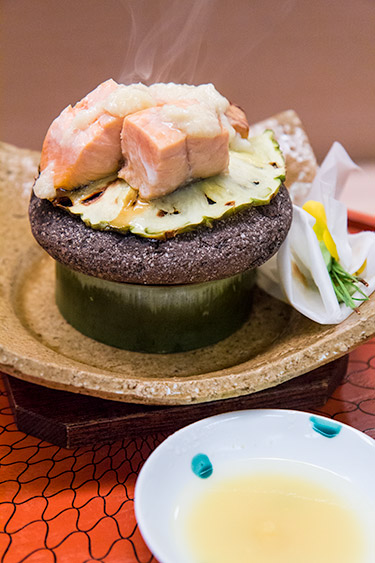
Gohan (御飯) and Kō no mono (香の物): A rice hot pot with a very seasonal (and bitter) fern with shredded bamboo shoots, served together with assorted pickled vegetables. The darling tells me that this fern only grows in the wild and is known for being very good for health - which perhaps sort of explains its' medicinal aftertaste.

We're also pretty stuffed, so we're stoked that the main course is over and we're moving on to Mizumono (水物) (dessert). There's always room for dessert, especially one that looks this awesome. This is a Japanese Orange that's been hollowed out and filled with a nice cold citrusy jelly. We're told first to try the jelly on its' own, then add a few drops of orange liquer, and finally squeeze the orange juice from the top half over the remaining jelly before polishing it off. One dessert, three flavor profiles, awesome!

We also get some huge strawberries and berries in syrup. Maybe it's because the strawberry season is ending in Japan, or maybe it's because of just how sweet the previous dessert was, but we felt the strawberries were a little ... bland.
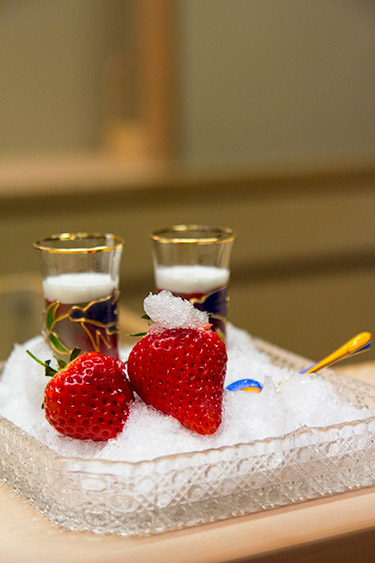
And for the final course of the night, a mochi ball-style confectionary and a delicate clear jelly cube with a cripsy sugar crust. Satisfying end to a satisfying meal.
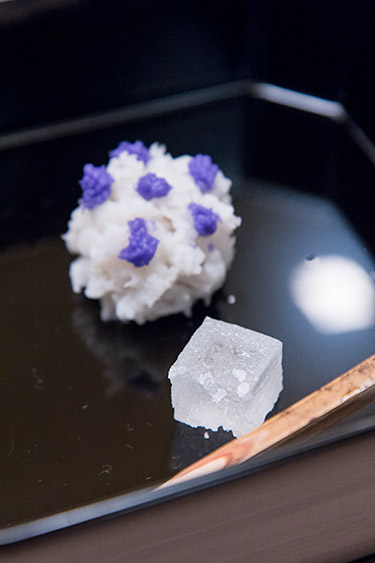
... well, not quite the end. Presumably to wash down the sweetness lingering on the tongue, we're given some green tea to end the night. This is proper, proper green tea - thick, concentrated, bitter, but miles better than those cheap crappy green tea bags we blanche in the office.

As we conclude our 10-course (or more, depending if you count the dessert as one course or three) dinner and pack up to leave, Chef Tanigawa comes out of the kitchen and chats with us, hands the darling a parting gift and to say thank you and goodbye.
Looking back on the meal we begin to understand the concept of the Kaiseki and it's focus on tasting the ingredient rather than overpowering it with seasoning. As compared to general western cuisine it's definitely much lighter tasting but no less delicious. What perhaps held us back from full appreciation of the meal was perhaps that there were a LOT of ingredients; some of which taste (flavor and texture) very different than the food we were raised on.
And as for the price? Cuisine and service of such level certainly won't come cheap; You get to choose from a range of prices between ¥14,000 and ¥25,000; ingredients used will vary depending on how much you want to pay. We chose the middle ¥20,000 option to which (roughly) ¥5,000 in charges and taxes were added on, bringing our total bill to ¥50,000 for two people. Totally worth it with no regrets, though!
Kichisen is near the Shimogamo shrine area and is reachable by bus; although coming by taxi can be a worthwhile alternative. If you're not very conversant in Japanese it's recommended to request your hotel / ryokan people to make the reservation on your behalf. Non halal.

wow, i like it!
ReplyDeleteLove to try... but need some time to save money for a meal
ReplyDeleteVery interesting site. I found you on Yahoo. I will be sure to recommend this to my co-workers. Keep up the great work!
ReplyDelete